VISIBILITY ENHANCEMENT IN LOW-LIGHT VIDEOS: A DEEP LEARNING-POWERED APPROACH
Keywords:
Low Light image, Computer Vision, Noise Reduction, Video AugmentationAbstract
Visibility in surveillance, security, and other applications can be severely limited by low light. Filters and post-processing techniques are frequently used in traditional ways of improving low-light movies. New opportunities for greatly enhancing visibility in low-light situations have been made possible by recent developments in deep learning and computer vision. Using filters and post-processing techniques are two common traditional approaches for improving low-light movies. These approaches, while somewhat successful, would not always yield acceptable outcomes and might not be appropriate for real-time applications. Creating a deep learning system that can make low-light videos easier to see is the main obstacle. This entails developing a model that can detect and adjust for low light levels while maintaining crucial details and cutting down on noise. For many uses, such as security, surveillance, and outdoor activities, it is essential to increase visibility in low light. Real-time video quality enhancement can result in more effective decision-making, enhanced safety, and higher efficacy in a range of situations. Under the project "Deep Learning-Powered Enhancement of Low-Light Video to Augment Visibility," the goal is to greatly increase low-light video visibility by utilizing the capabilities of cutting-edge deep learning algorithms. This project aims to create a system that can correctly and autonomously improve video quality in real-time by training models on large datasets of low-light video samples. Deep learning algorithms are very suitable for this purpose since they are excellent at discovering intricate links in data. This development might greatly improve vision in low light, which would eventually increase safety and efficacy in applications including outdoor activities, security, and monitoring








